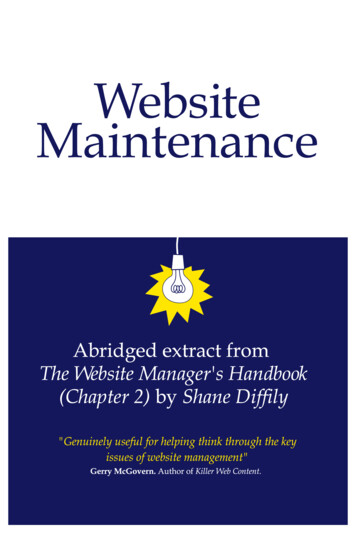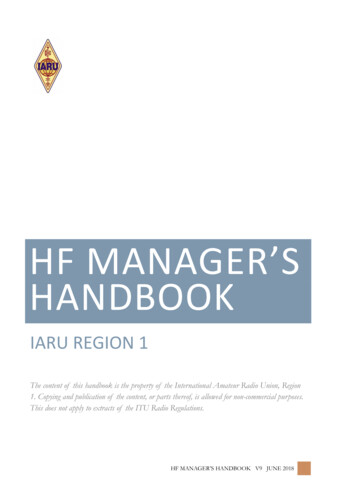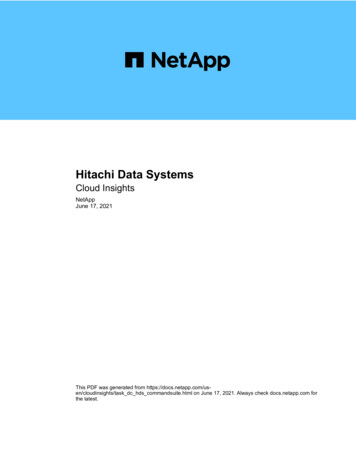
Transcription
The Website Manager’s HandbookThe Website Manager’s HandbookThis document contains an abridged extract from “Chapter 2: WebsiteMaintenance” of The Website Manager’s Handbook by Shane Diffily.The Website Manager’s Handbook gives youa practical model for the management andmaintenance of your website or intranet.Through it you can learn about all theprocesses, people, technology and otherresources you need to manage a successfulsite.Join the hundreds of web professionalsand universities who rely on The Website Manager’s Handbook foradvice about online operations.Visit www.diffily.com/book for more.The Website Manager’s HandbookISBN: 978-1-4116-8529-1 Copyright Shane DiffilyPraise for The Website Manager’s Handbook"Very clear and well written a lot of practical depth I'm sure thatsomeone managing—particularly a large website—would find itgenuinely useful to help them think through the key issues in websitemanagement."Gerry McGovern. Author of Content Critical.i
Table of ContentsWhat is Website Maintenance?.1Website Maintenance Team . 2How many staff you need . 2Activity 1 Website Publishing . 7Website Publishing Team . 7Website Publishing Process . 10Publishing Resources . 11Activity 2 Website Quality Assurance . 13Data Collection. 13Activity 3 Website Feedback Monitoring . 15Activity 4 Website Performance Monitoring . 19Website Activity. 19Subscriber/Sponsor Opinions . 21Activity 5 Website Infrastructure Performance Monitoring. 22Technical Support Team. 22Activity 6 Website Change Control . 25Change Control Process. 25ii
The Website Manager’s HandbookWhat is Website Maintenance?Website Maintenance comprises all the activities needed to ensure theoperational integrity of your website or intranet. In other words, it isabout doing all the things needed to make sure your site runs smoothlyand according to plan.The activities from which Website Maintenance is composed are: Website Publishing: To keep content up-to-date. Website Quality Assurance: To spot errors on a site. Website Feedback Monitoring: To manage communication withwebsite visitors. Website Performance Monitoring: To measure success. Website Infrastructure Monitoring: To supervise hosting. Change Control: To manage technical and other changes in a coordinated way.These activities are usually carried out by members of a WebsiteMaintenance Team.1
Website MaintenanceWebsite Maintenance TeamA Website Maintenance Team is responsible for expediting the tasks ofsite maintenance.The variety of roles on such a team is usually quite broad and mayinclude the following: Website Maintenance Team Leader Publishing Representative (Editor) Quality Assurance Representative Feedback Monitoring Representative Website Performance Representative Infrastructure Monitoring Representative Change Control RepresentativeIt is worth bearing in mind that if your site is small, you may not have toallocate one person for each activity. Instead, you could combine severalroles together.For example, an Editor could also act as a Team Leader, as well as lookafter Quality Assurance or Feedback Monitoring.Yet, even such small teams must still have all necessary skillsrepresented. This is because each one is vital for maintaining a qualityweb presence.How many staff you needA useful device for deciding the number of people you need for yourmaintenance team is ‘Website Scale’.2
The Website Manager’s HandbookFigure 1. The Website Maintenance Team.Website Scale is a means of classifying a site in terms of three parameters: Size Complexity Levels of activityAny site can be represented in this way—from a small, plain text websiteto a massive corporate intranet.3
Website MaintenanceWebsite SizeA website’s size is an estimate of the total man-hours required to produceand maintain all the content that it contains. This can then be used tocalculate the number of people required for support—particularly theactivities of Website Publishing and Quality Assurance.Small WebsiteContent Man Hours per Annum : 1,500–4,000Staffing Levels for Content Publishing and QualityAssurance: About 1–2 people.Medium WebsiteContent Man Hours per Annum : 4,000–10,000Staffing Levels for Content Publishing and QualityAssurance: About 2-3 people.Large WebsiteContent Man Hours per Annum : 10,000 Staffing Levels for Content Publishing and QualityAssurance: From 2-3 people upwards.Figure 2. The three levels of Website Size.Website ComplexityComplexity is a function of the intricacy of the technology used todevelop a site. There are three levels of website complexity:Basic WebsiteSuch ‘brochureware’ sites simply contain plain text with perhaps a fewsupporting images and downloads, e.g. PDFs.Dynamic WebsiteOn a Dynamic site content is stored in a database and publishedaccording to the requirements of site visitors. Some also offer basicinteractive services, e.g. Discussion Forums.4
The Website Manager’s HandbookTransactional WebsiteA Transactional website is one that uses the internet for facilitatingbusiness operations or generating revenue. Sites of this type rely ondatabases and other advanced technology for collecting and processingorders.Some indicative figures for the staffing of a Technical Team are indicatedin the following table:Basic WebsiteContent: Plain content (HTML/XHTML).Staffing Level for Infrastructure Monitoring andChange Control: 1 person (for a small to medium sizedsite).Dynamic WebsiteContent: Dynamically generated from a database.Staffing Level for Infrastructure Monitoring andChange Control: 1 or 2 people (or more on a very large orbusy site).TransactionalWebsiteContent: Fully transactional content, e.g. eCommerce.Staffing Level for Infrastructure Monitoring andChange Control: From 1 or 2 people upwards (manymore on a large or busy site).Figure 3. The three levels of Website Complexity.Website ActivityWebsite Activity is a measure of the traffic experienced by a site, e.g.Page Impressions, Visitors, Visits, etc. A website with heavy activity isunlikely to function properly without a full complement of maintenancepersonnel.A Busy site that is also Large in size and Transactional in nature mayneed dozens of staff to keep it going.5
Website MaintenanceQuiet WebsitePage Impressions: 0–100,000 a monthTotal Team Staffing: Between 1 and 3 people.IntermediateWebsitePage Impressions: 100,000–1,000,000 a month.Busy WebsitePage Impressions: 1,000,000 a month.Total Team Staffing: About 2-3 people.Total Team Staffing: From 3 people upwards (many moreon a very busy Transactional site).Figure 4. The three levels of Website Activity.6
The Website Manager’s HandbookActivity 1Website PublishingThere is no point in having great information online if you have nomechanism for looking after it. As we will now see, a good system of thistype must be built on the twin pillars of a well resourced team and anorderly process.Website Publishing TeamA Publishing Team is the group of people responsible for managing thelifecycle of online content. Such a team is typically composed of an Editorand representatives from each major areas of publishing activity,including: Content Contributors Designer Developer Moderator Legal Reviewer7
Website MaintenanceFigure 5. The Website Publishing Team.Website EditorA Website Editor is answerable for everything that is published on a site,e.g. accuracy of information, suitability of images, etc. The core activitiesfor which she is accountable are concerned with the lifecycle of content,such as:8 Reviewing and editing work-in-progress Maintaining existing content Responding to user comments about existing content Planning and commissioning new content
The Website Manager’s HandbookTo co-ordinate these activities the Editor may convene a regular WebsitePublishing Meeting at which everyone involved in the creation, reviewand approval of online content is gathered.Content ContributorContent Contributors are commissioned to produce new features orupdate existing content for a website, based on the requirements of aPublishing Schedule. Ideally, Contributors should be experiencedprofessionals (e.g. journalists) who have been specially recruited for theirskills.ModeratorA Moderator is responsible for the regulation of User Generated Content,e.g. wikis, discussion forums, user contributed video or imagery, etc.Websites with vulnerable audiences (e.g. children) need particularlydetailed oversight.Legal ReviewerThe role of a Legal Reviewer is to ensure that all content intended forpublication on the web is in compliance with the law (and any otherregulations or policies). In a small organisation where no legaldepartment exists, the Editor may adopt this function.DesignerThe role of a Designer is to find the optimum solution for the visual andinteractive presentation of content on the web. Designers usually workclosely with Content Contributors, Developers and the Editor to create anagreed outcome.9
Website MaintenanceDeveloperA Developer converts content and design into a web-readable format andthen publishes it on the internet.The traditional approach for making web pages is to build a HTML fileinto which text, images and other media are inserted. Medium-to-largescale sites may also use other ‘server-side’ and ‘client-side’ scriptinglanguages such as ASP, PHP, Ruby, JavaScript, etc.Website Content ManagementIn recent years some Developer activities have been superseded byWebsite Content Management (WCM).The advantage of WCM is that it allows Content Contributors to publishdirectly to the web—bypassing the coding ‘bottleneck’. WCM also resultsin great savings of time for Developers themselves and allows them tofocus on more valuable activities.Website Publishing ProcessThe objective of a Publishing Process is to ensure content is created,reviewed and approved in a controlled manner. A typical process of thistype could reflect the following steps:StepRolesDescriptionStep 1ContentContributorContent is produced by a ContentContributor in accordance with thestipulations of a Briefing Document.Step 2EditorWhen received by the Editor, he reviews itand makes whatever changes are necessary.Step 3Legal/RegulatoryReviewerWhen approved by the Editor, the completedcontent is sent for Legal/Regulatory Review.10
The Website Manager’s HandbookStep 4Designer &DeveloperFollowing Legal/Regulatory clearance, it isprepared by the Designer and the Developer.Step 5EditorWhen the content is complete, it is commonfor the Editor to have a final review. In thecase of sensitive items, e.g. homepage, theWebsite Management Team may wish toclear changes before they golive.Step 6DeveloperThe content is returned to the Developerwho places it on the live website.Step 7EditorWhen the content is live the Editor conductsa final review to ensure it is presented asintended.There are several benefits to such a system. These include: It prevents unauthorised content being published. It allows work to be monitored and scheduled more effectively. It allows publishers to anticipate the stages through which workmust pass before going live. (This helps shape expectations abouthow soon items can be expedited.) It has the knock on effect of encouraging Content Contributors toproduce better quality content (as they know it will be reviewedbefore being released).Publishing ResourcesEach member of a Website Publishing Team needs some form of toolkitto help them produce good content.Editor’s Publishing PackThe Editor’s Publishing Pack contains all the resources required to ensurerules for language, style and design can be properly adhered to. Theseinclude:11
Website Maintenance Website Standard Website Style Guide Company Policies Organisational Identity Manual Dictionary Thesaurus Grammar GuideContent Contributor’s Publishing PackThe Content Contributor’s Pack generally contains all of the sameelements as the Editor's Pack, though some may be abridged form only.Legal Reviewer’s Publishing PackThis consists of extracts from legislation and regulations, as well as acollection of company policies against which web content must becompared.Designer’s Publishing PackThe Designer’s Pack contains much the same resources as found in theEditor’s Pack, though other specialist items are also included.This includes a library of images, typefaces and audio-visual material, aswell as the design software needed to develop them.Developer’s Publishing PackA Developer’s Pack contains the software needed to create and editwebsite code.12
The Website Manager’s HandbookActivity 2Website Quality AssuranceQuality Assurance is the activity that makes sure a website isoperationally sound and in conformance with an organisation’sstandards.The two main activities of Website Quality Assurance are DataCollection and Data Analysis.Data CollectionThe aim of this task is to collect the data against which a website can beexamined for issues of quality. This includes: Checking for broken links Checking for missing content, e.g. images Checking for missing browser titles Checking the spelling and grammar of content Checking for missing metadata Checking the file sizes of pages to ensure they are not too large13
Website Maintenance Checking for browser compatibility Checking that applications are functioning correctly, e.g. anonline hotel reservation form Checking that legal and regulatory guidelines are being adheredto, e.g. data protection and privacy Checking that pages conform to your organisation’s WebAccessibility standard (if any) Checking that the Website Design standard is maintainedA variety of automated tools are now available that make data collectionmuch faster and easier.Data AnalysisData Analysis examines all the information that has been collected andfrom that an Issues Log is compiled. The purpose of this log is to listitems that are in violation of a QA checkpoint, e.g. broken links,oversized images, etc. These can then be allocated to Developers foradjustment.14
The Website Manager’s HandbookActivity 3Website Feedback MonitoringWebsite Feedback Monitoring is a process for regulating and respondingto communications from your site’s visitors in a controlled and timelymanner. This process is often overseen by a Feedback Co-ordinator.The role of a Feedback Co-ordinator is to ensure customer messages areacknowledged and responded to in a timely manner. His duties includethe following:1.Collect the feedback2.Acknowledge receipt of the query3.Investigate (if appropriate)4.Make a full response and manage any follow-up correspondence5.ArchiveThe manner in which feedback is managed can differ based on thechannel through which correspondence is received. This includes:15
Website Maintenance Email Bulletin Board Chat Instant Messaging Satisfaction Ratings Telephone PostEmailWhere feedback is received by email, receipt of customers’ messagesshould be acknowledged either immediately or within 24 hours.Acknowledgement emails may also be automated if large numbers arereceived.Figure 6. Web form from Wired.com showing how feedback can be sorted by type.Feedback Bulletin Board or Discussion ForumBulletin boards are sometimes used to gather feedback. Feedbackreceived in this way may be responded to in a manner similar to email.16
The Website Manager’s HandbookThat is, acknowledgements and subsequent messages are posted on theboard for the attention of all users.Online ChatChat is resource intensive and is only recommended for websites thathave appropriate levels of staffing. Where communication is authorisedby this method, the most important requirement is to set the timesduring which service is available.Figure 7. Online chat service from the self-publishing firm, Lulu.Instant MessagingInstant Messaging follows much the same model as Online Chat. Thedrawback is that website visitors must have appropriate softwareavailable on their computers.Satisfaction RatingsMany websites now include in-page features that allow visitors to ratecontent and provide comments about it. Such ratings are then sent toauthors, who use them as a basis for improving information.17
Website MaintenanceFigure 8. Satisfaction rating form from Microsoft.comTelephoneIn the event that your website is unavailable, one of the few remainingfeedback channels is the telephone. Contact in this way may be necessaryif, for example, a website is undergoing maintenance and needs to beshut-down temporarily.PostGood old ‘snail mail’ can also be used to submit feedback. As such, youmust make sure a postal address is published somewhere on yourwebsite.18
The Website Manager’s HandbookActivity 4Website Performance MonitoringWebsite Performance Monitoring is the activity that gathers and analysesdata against which the success of a website can be evaluated.To this end, it is important that your Maintenance Team know the KeyPerformance Indicators (KPIs) against which their site is beingevaluated.KPIs are the targets that have been selected by management fordetermining online success. The three most commonly used are: Website Activity (traffic) Visitor Feedback (this was explored in Activity 3) Subscriber/Sponsor FeedbackWebsite ActivityWebsite Activity is a measure of the traffic experienced by a site. Thethree most frequently monitored figures include:19
Website Maintenance Visits: A visit is an instance of a unique visitor accessing awebsite. Visitors: A visitor is the originator of a visit, i.e. the person whobrowses a website. Page Impressions: A Page Impression is a ‘hit’ on a page thatcontains content. (The recent growth of Rich InternetApplications built on AJAX and Flash means there is now lessemphasis on this as a metric of success.)Financial KPIs are of great importance for many firms. Such measuresencompass the following themes: Acquisition: The cost and value of attracting visitors. Conversion: The cost and value of making a sale. Retention: The cost and value of customer loyalty.The Tools of Website Traffic AnalyticsA huge market has grown around technology called Website TrafficAnalytics. These are tools that extract and analyse data about web traffic.Many products of this type are free and can be downloaded from theinternet. However, high quality analysis usually requires investment in aprofessional system. These come in two forms: Standalone Solution: Where software is installed directly on thecomputer that hosts the website and then analyses its activitylogfile, e.g. WebTrends. Application Service Provider Solution: Where measurementsare gathered over the internet using ‘tags’ that are placed intoevery page on a website, e.g. Google Analytics.20
The Website Manager’s HandbookFigure 9. A screengrab from the website of Google Analytics.Subscriber/Sponsor OpinionsAs seen already, Feedback Monitoring is crucial for any site that wishesto maintain a happy audience.However, the opinions of ordinary site visitors are only part of the story.There are two classes of user whose comments and suggestions are ofeven greater significance. These are: Subscribers: A subscriber is a power-user of a site, e.g. someonewho has registered as a member of a discussion forum and whouses it very regularly. Sponsors: A sponsor is someone who is willing to pay for theservices provided by a website, e.g. by paying a fee to post anadvertisement online. They therefore constitute an importantstakeholder group whose opinions must be listened to.Many Dynamic and Transactional websites boast large audiences of bothsubscribers and sponsors.21
Website MaintenanceActivity 5Website InfrastructurePerformance MonitoringThe aim of Infrastructure Performance Monitoring is to create proceduresfor the supervision of site hosting. Website hosting refers to the servicethat allows a website to be stored on and accessed from the internet.Typically, the group of people in charge of this area is called theTechnical Support Team.Technical Support TeamThe size of your Technical Support Team and the range of skillsrepresented on it depends on the complexity of the infrastructure youhave in place. For example, a single person with rudimentary skills maybe all that is needed to look after a small Basic site. However, a big, busyTransactional website will require many more personnel.The most common skills included on a Technical Team are:22
The Website Manager’s Handbook Software Management: The maintenance of the software used tohost a site. Hardware Management: The maintenance of hosting hardware. Information Systems Security: Web security. Data Maintenance.Figure 10. Website Technical Support Team.Service Level AgreementAn SLA is a document that stipulates metrics by which the technicalperformance of a site can be assessed. The most common measuresrepresented within an SLA include: Website Availability: The percentage of time that a website is upand running. Website Reliability: The number of unplanned outages thatoccur on a website.23
Website Maintenance Website Responsiveness: The speed with which a websiteresponds to traffic.A range of technology is available to monitor site Availability, Reliabilityand Responsiveness. Among the analysis they provide is: Server response times End-User response times Server error rates and types Processor loads Hard disk utilisation Bandwidth utilisation Traffic patterns Queue sizes TimeoutsPerformance Monitoring tools like these are essential for sites that aim toprovide a high level of service.24
The Website Manager’s HandbookActivity 6Website Change ControlThe responsibilities of site maintenance extend beyond issues ofimmediate operations. They are also concerned with developments thathave the potential to affect future integrity. In this sense, a mechanism isneeded by which the impact of amendments can be managed.Change Control is a process for implementing technical and otherupdates to a website in a timely and non-disruptive manner.Change Control ProcessThe process by which Change Control is managed comprises four steps.These are:1.Identify the nature of the change2.Identify the scale of the change3.Identify any possible impact4.Proceed or re-evaluate25
Website Maintenance1. The Nature of the ChangeThe most common amendments covered by Change Control concern theinfrastructure of site hosting and the technology used to deliver content 1 .These can be grouped into four categories: Changes arising as a result of software maintenance. Changes arising as a result of hardware maintenance. Changes arising as a result of the initial release of content using anew technology. Changes arising as a result of marketing activity.2. The Scale of the ChangeThe scale of a change measures the amount of an existing infrastructurethat is affected by it. It also determines the quantity of resources requiredto make the change happen.3. The Impact of the ChangeThe impact of a change is a measure of its effect on site visitors, businessoperations or site administration. Managing impact is all aboutminimising the risk that any of these will be affected.There are a number of attributes that should be reviewed before anyactivity commences. These provide a means of identifying elements thatare particularly vulnerable to adjustment, such as:1 Event Sensitive Applications Business Critical Content Frequently Used ContentAmendments that arise from the ordinary activities of Publishing or Quality Assuranceare excluded (unless they involve significant new technology).26
The Website Manager’s Handbook4. Proceed or Re-evaluateOnce all the facts have been considered, the decision to proceed with thechange (or not) must be taken.Where the evidence suggests that the risk of a negative impact is withinacceptable limits, the project can proceed as planned. However, wherethe risk is unacceptable, the change itself or the process ofimplementation must be reconsidered.Contingency and TestingIn case things go wrong, a contingency plan should be put in place forevery change that occurs. For example, if a software upgrade fails, itmust be possible to halt the implementation and revert to a previousstate with no loss of data.Finally, once a change has been made, website testing must ensue tomake sure the site continues to function as intended. The affected siteshould also be closely monitored for several weeks. This is because thefull impact of a change may not become obvious for some timeafterward.27
About the AuthorShane Diffily has many years experience in websitemanagement. He is currently employed as a SeniorAnalyst with iQ Content—one of Europe’s leadingweb consultancies (www.iqcontent.com).As an experienced writer, Shane has publishedseveral articles for the respected design journalAlistpart.com. He has also written numerous casestudies on technology and business for The Irish Times ‘Business2000’(Ireland's leading broadsheet newspaper).Shane lives in Dublin, Ireland.Visit www.diffily.com for more articles and advice about websitemanagement and maintenance.28
The Website Manager’s HandbookIndexActivity, website, 5, 19Analytics, website, 19, 24tools, 20maintenance, 26management, 23HTML, 10Applications, web, 14Identity manual, 12ASPInfrastructureApplication Service Provider (websiteanalytics), 20Bandwidth, 24Browsercompatibility, 14performance monitoring, 22Instant Messaging, 17Intranet, 3Key performance indicators, (KPIs), 19,20Bulletin board, 16Law, 9Change control, 25Legal reviewer, 7process of, 25Chat, 17Complexity, website, 4, 22ContentLinksbroken, 13Mailfeedback, 18contributor, 7, 9Maintenance, 1maintenance, 4Maintenance, team, 2publishing, 7Database, 4skills, 2ManagementDesigner, 7, 9server hardware, 23Developer, 7, 10server software, 23Dictionary, 12Editor, 8, 9, 11Emailfeedback, 16Error. See Quality Assuranceserver, 24Feedback, 15co-ordinator, 15email, 16Grammar, 12HardwareManagement, websitecontent, 10Moderator, 7, 9Page Impression, 5PDF, 4Performance measurement, 19infrastructure, 23Postfeedback, 18Publishing, 7meeting, 929
pack, 11, 12Sponsor, 21process, 10Staffing. See Skillsresources, 11Standard, website, 12Quality Assurance, 13activities of, 13RatingSubscriber, 21Teamperformance monitoring, 20staffing, 3visitor satisfaction, 17technical support, 22Reliability, website, 23, 24Responsiveness, website, 24Reviewlegal, 9Satisfactionfeedback, 17Securityinformation systems, 23Service Level Agreement (SLA), 23Sizewebsite, 4Skillstechnical team, 22Software, 27feedback monitoring, 15infrastructure performancemonitoring, 24management, 23website analytics, 20website content management, 1030Style guide, 12website maintenance, 2website publishing, 7Telephonefeedback, 18Testing, website, 27Textpublishing, 7Thesaurus, 12Traffic, website, 24analytics, 20Visitor, websitefeedback, 16satisfaction rating, 17sponsor, 21subscriber, 21Website publishingteam, 7Website scalefactors of, 3Website standard, 12
Website Maintenance 6 Quiet Website Page Impressions: 0-100,000 a month Total Team Staffing: Between 1 and 3 people. Intermediate Website Page Impressions: 100,000-1,000,000 a month. Total Team Staffing: About 2-3 people. Busy Website Page Impressions: 1,000,000 a month. Total Team Staffing: From 3 people upwards (many more on a very busy Transactional site).










